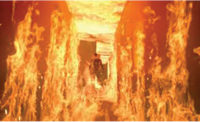History
In 2000, the National Fire Protection Association developed NFPA 2112, an industry standard on flame-resistant garments for protection of industrial personnel against flash fire. NFPA 2112 provides minimum performance criteria and sets clear guidelines for testing on instrumented thermal manikins.
The standard calls for flash fire testing to be conducted at three seconds with a pass/fail rate of 50 percent total body burn under ASTM F1930 (Standard Test Method for Evaluation of Flame Resistant Clothing for Protection Against Flash Fire Simulations Using an Instrumented Manikin) testing protocols.
Scope
The National Fire Protection Association 2112 Standard provides minimum requirements for the design, construction, evaluation, and certification of flame-resistant clothing for use by industrial personnel. It does not attempt to provide any guidance on matching the PPE to the quantified hazard — that is what NFPA 2113 is designed for.
Why this standard is important
For workers in the chemical, petroleum and related industries flash fires, a fire that spreads rapidly through a diffuse fuel, is a concern that requires specific personal protective equipment. In order to provide protection and reduce the severity of burn injuries from flash fires, processors should follow the National Fire Protection Association (NFPA) 2112 standard. Flash fires generate temperatures in the range from 1000ºF to 1900ºF.
Most severe burn injuries and fatalities are caused by non-flame resistant clothing igniting and continuing to burn. In fact, the body area under non-FR clothing is often burned even more severely than exposed skin.
When workers are exposed to flash fires while wearing “everyday” fabrics, those fabrics can ignite, melt and continue to burn which in turn increases the injury and could lead to death. This includes common fabrics like:
- Cotton
- Polypropylene
- Acetate
- Polyester
- Nylon
- Wool
OSHA’s Enforcement Policy for Flame-Resistant Clothing in Oil and Gas Drilling, Well Servicing, and Production-Related Operations published in March of 2010 clarified OSHA's policy for citing the general industry standard for personal protective equipment (PPE), 29 CFR 1910.132(a). Safety managers in the oil and gas industry were faced with a new challenge: to provide flame resistant (FR) clothing for employees exposed to flash fire hazards. There were delays in the adoption of FR clothing in the oil and gas industry. Some hindrances to full adoption of FR clothing across the industry included:
- Less mature understanding of the importance and adoption of FR clothing (compared to other industries like electric utilities and oil refining)
- Confusion over selecting and specifying FR clothing
Hazards
Fires usually are extensive when they occur at manufacturing, chemical, and petroleum-based industrial sites. Short-duration fires are a rare exception. Three seconds is a performance specification that is only used to qualify a garment as FR. It has nothing to do with establishing the correct level of PPE workers need in your particular fire hazard environment. Flash fires may occur in environments where fuel, typically flammable gas or dust, is mixed with air in concentrations suitable for combustion.
Flash fire is a particular danger in enclosed spaces, as even a relatively small fire can consume enough oxygen and produce enough smoke to cause death of the persons present, whether by asphyxiation or by smoke inhalation
What must employers do to protect employees?
NFPA 2112 standard “shall specify the minimum performance requirements and test methods for flame-resistant fabrics and components and the design and certification requirements for garments for use in areas at risk from flash fires.” By following these standards, employers will be able to provide their employees garments to protect them from the dangers of flash fires.
When purchasing fire-resistant (FR) garments, employers must note several performance requirements as well as various testing that must be completed to ensure the garments will protect against flash fires. The NFPA also notes that manufacturers must provide users with information including warnings, information and instructions with each FR garment as well as a sizing chart indicating the range of key wearer measurements.
General requirements
NFPA 2112 standard specifies:
- The minimum performance requirements for flame-resistant fabrics and components (for fabric, thread, hardware, and labels)
- Test methods for flame-resistant fabrics and components (six tests)
- The design requirements for garments for use in areas at risk from flash fires (for hardware finishes, metal components, slide fastener tapes)
- Certification requirements for garments for use in areas at risk from flash fires (certification program, inspection and testing, quality assurance program)
The major test in the certification program is the full-scale flash fire test (Instrumented Mannequin) according to ASTM F1930 Standard Test Method for Evaluation of Flame Resistant Clothing for Protection Against Fire Simulations Using an Instrumented Mannequin.
An instrumented mannequin is a unique and very complex test system representing a human body. It is equipped with a minimum of 100 thermal energy sensors uniformly distributed within each area in the mannequin. After the test garment is on, the mannequin is exposed to flames simulating a flash fire. The duration of flame exposure is three seconds. Data from the test is used to calculate burn percentage for second and third degree burns.


